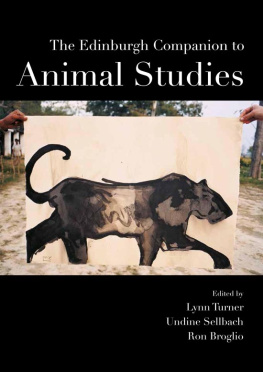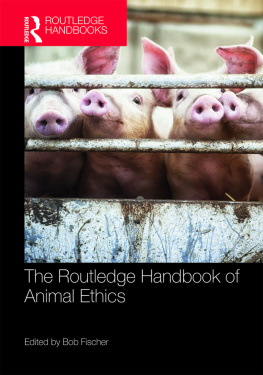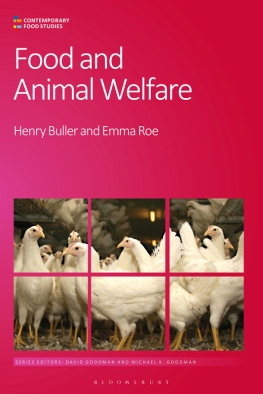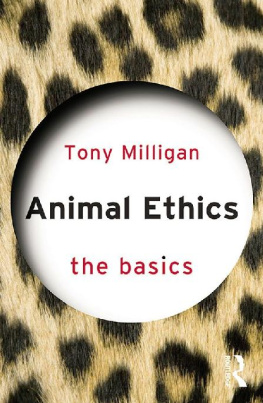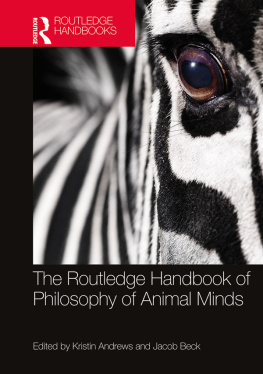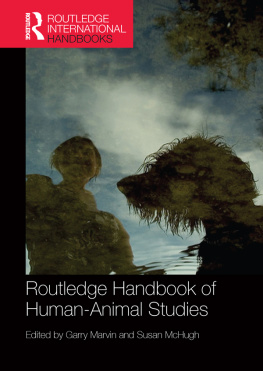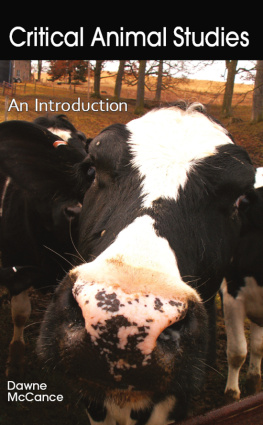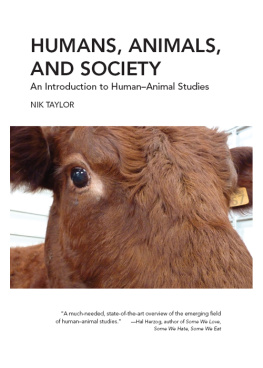
T HE E DINBURGH C OMPANION
TO A NIMAL S TUDIES
To the animals
T HE E DINBURGH
C OMPANION TO
A NIMAL S TUDIES
E DITED BY L YNN T URNER , U NDINE S ELLBACH AND R ON B ROGLIO
EDINBURGH
University Press
Edinburgh University Press is one of the leading university presses in the UK. We publish academic books and journals in our selected subject areas across the humanities and social sciences, combining cutting-edge scholarship with high editorial and production values to produce academic works of lasting importance. For more information visit our website: edinburghuniversitypress.com
editorial matter and organisation Lynn Turner, Undine Sellbach and Ron Broglio, 2018
the chapters their several authors, 2018
Edinburgh University Press Ltd
The Tun Holyrood Road, 12(2f) Jacksons Entry, Edinburgh EH8 8PJ
Typeset in 10/12 Adobe Sabon by
IDSUK (DataConnection) Ltd, and
printed and bound in Great Britain.
A CIP record for this book is available from the British Library
ISBN 978 1 4744 1841 6 (hardback)
ISBN 978 1 4744 1842 3 (webready PDF)
ISBN 978 1 4744 1843 0 (epub)
The right of Lynn Turner, Undine Sellbach and Ron Broglio to be identified as the editors of this work has been asserted in accordance with the Copyright, Designs and Patents Act 1988, and the Copyright and Related Rights Regulations 2003 (SI No. 2498).
C ONTENTS
L IST OF I LLUSTRATIONS
Jane Alexander, Security, Johannesburg Art Fair, 2009.
Arnold and Arlene, Museum of Natural History, New York, 2016.
Rear view of Arnold and Arlene, Museum of Natural History, New York, 2016.
Bodies of Evidence, Museum of Natural History, New York, 2016.
Beneath the Surface, Museum of Natural History, New York, 2016.
Polly Morgan, Still Birth, Red, 2016.
Kathy High, Embracing Animal, 20046.
Pierre Huyghe, Zoodram 4, 2011.
Silvia Celiberti, Pig in the Garden, The In Vitro Meat Cookbook.
Oron Catts, Chris Salter, Devon Ward, Ionat Zurr, Futile Labor, 2015.
Mbius strip.
A CKNOWLEDGEMENTS
M ANY THANKS to all those making this volume possible: Edinburgh University Press for the commission; the contributors for their daring new work; artists Olly and Suzi for permission to reproduce their work on the cover; and the colleagues, known and unknown, who advised and refereed along the way.
I NTRODUCING T HE E DINBURGH C OMPANION
TO A NIMAL S TUDIES
Lynn Turner, Undine Sellbach and Ron Broglio
Companion comes from the Latin cum panis, with bread. Messmates at table are companions. Comrades are political companions. A companion in literary contexts is a vade mecum or handbook, like the Oxford Companion to wine or English verse; such companions help readers to consume well.
(Donna J. Haraway)
T HE INVITATION TO edit a reference work under the heading of The Edinburgh Companion to Animal Studies immediately called to mind the influential work of Donna Haraway, broadly in light of her long-term development of the field and specifically in terms of her dilation of the name companion and provocation as to what might constitute companion species. It is ironic that no one chapter became dedicated to it. Rather, this vexatious, intriguing, capacious term infected the book overall, directly inflecting numerous chapters from Ethics to Empathy to Microbes to Science Fiction, provoking a wide range of responses as to what company might entail, speaking to our editorial process and prompting the opening thoughts of this introduction.
A Study
Tigers may not want to break bread with us, or keep our conspicuous company around a literal table (while they may be constrained to do so in the spectacular hothouse of the zoo, as in Bonnie Ora Sherks Public Lunch performance, discussed in the chapter on Food). Nevertheless, we are unavoidably companions in Haraways sense quoted in our epigraph, becoming-with others in diverse and unexpected ways. For our opening foray we turn to a particular tiger.
Black Tiger is an animal study made by expedition-based artist duo Olly and Suzi in one of the tiger reserves of Uttar Pradesh in India during 1998. A large sheet of paper is held up, like a banner to be photographed. Black ink runs in varied densities across the sheet of paper, settling into the outline of a tiger ambling along. The narrow rim between the paper and photograph edge exposes glimpses of sand, sky, buildings, trees, grass and the distant outline of a man. This is possibly one of the trackers who helped the artists follow this tiger, not to hunt, but in order to paint her picture. Hands on either side of the drawing bear it aloft, making sure that it is seen. The tiger is walking head down, tail curled, belly digesting. If her coat has stripes, they are obscured. Her painted legs, poised to leave paw prints in the sand, are cropped by the bottom edge of the paper.
That is to say, they are at serious risk of extinction in the foreseeable future.
When this volume was commissioned the World Wildlife Fund had already announced that the world had lost half of all wildlife over the last forty years, a petrifying rate with dismal prognosis for remotely recognisable multispecies futures. No one can seriously imagine that such climate change denial is a failure to understand science that might be solved by a plainer explanation. Clearly it is a wilful refusal to acknowledge thinking and practices that challenge the embedding of private profit in multinational corporate interests, frequently identified with fossil fuel industries.
Held up like a banner, Black Tiger can be read as a call to activism, a rallying point to draw in new publics. But the suspended paper is also a subtle membrane between diverse ecologies, expanding potential sites of political action by bringing various edges disjunctions, infestations, exposures and collaborations to the fore. These uncertain pictorial edges are often edited out when we represent or address animals, but they have become pressing for animal studies scholarship, given the entangled ways that different lives animal and otherwise come to matter.
In the process of writing this collaborative account of Black Tiger we find ourselves fielding what counts as the coordinates of the picture beyond its visible borders. Only too frequently in the Western cultural imaginary our relation with and to animals has primarily been one of definite borders, distancing and denial. A critical activity of framing and reframing denaturalises dominant ways of seeing and scaling animals, bringing into focus kinships, stories, affects and dependencies that may otherwise be elided. Building on an extensive tradition of animal studies scholarship, this is one of the important undertakings of this volume. But the narrow field between paper and photographic edge, and the ambiguous script of the tigers gut are also reminders of the many ecological relations entangling animal and human lives. These relations are often too tiny or vast, ubiquitous or singular, subliminal, multiple or discordant to be studied through one lens, or to register as familiar sentient states or attunements. Thus a second provocation of this Companion, always made in conjunction with the first, is for animal studies to cultivate new kinds of peripheral attention, improvised imagination, interdisciplinary diplomacy and interspecies company.
Artists, paper, photographer and the viewers implied presence are all in his line of sight. We understand that the two artists that sign this work are formalised as a duo, but hands and gaze tease the scene out further in diverging directions.
Next page
